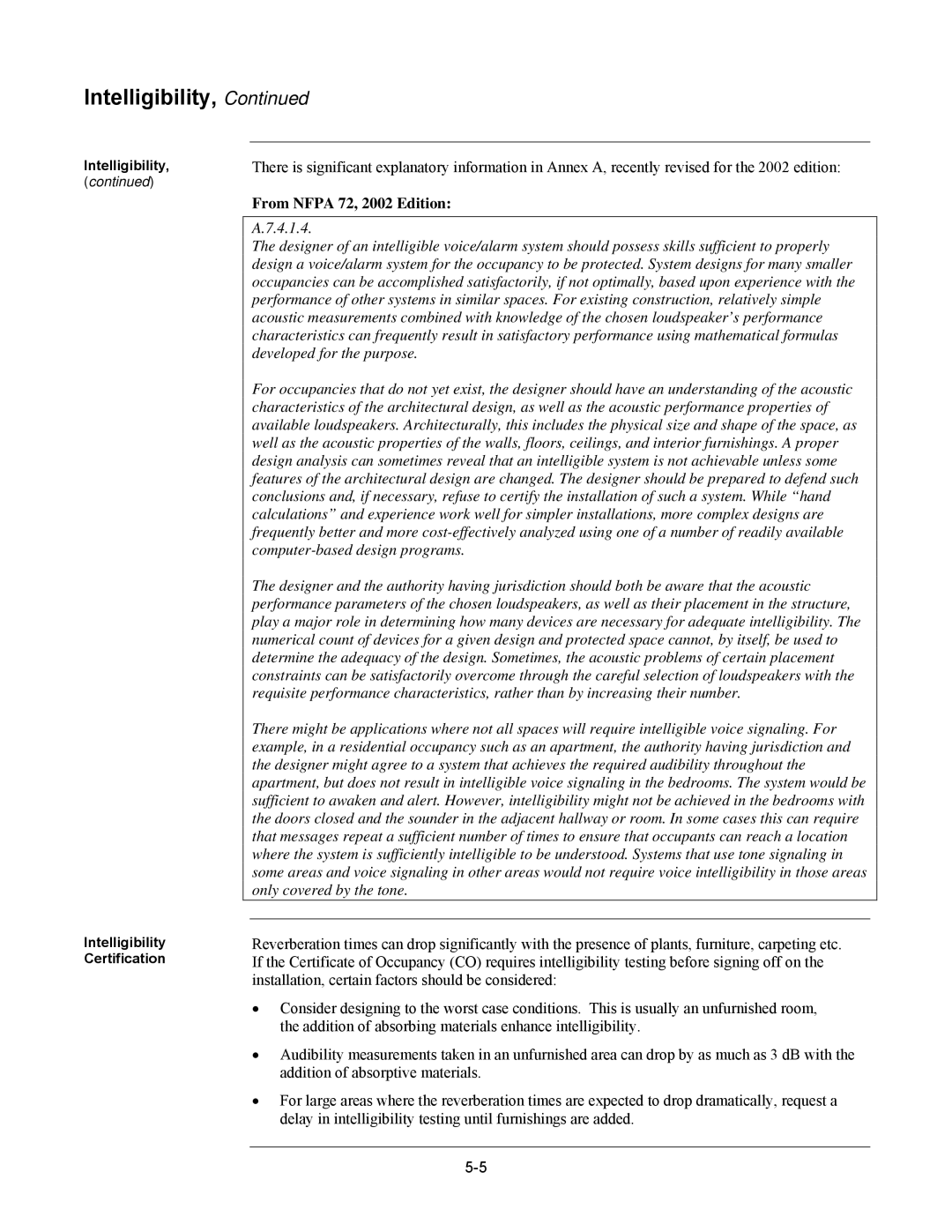
Intelligibility, Continued
Intelligibility, | There is significant explanatory information in Annex A, recently revised for the 2002 edition: |
(continued)
Intelligibility Certification
From NFPA 72, 2002 Edition:
A.7.4.1.4.
The designer of an intelligible voice/alarm system should possess skills sufficient to properly design a voice/alarm system for the occupancy to be protected. System designs for many smaller occupancies can be accomplished satisfactorily, if not optimally, based upon experience with the performance of other systems in similar spaces. For existing construction, relatively simple acoustic measurements combined with knowledge of the chosen loudspeaker’s performance characteristics can frequently result in satisfactory performance using mathematical formulas developed for the purpose.
For occupancies that do not yet exist, the designer should have an understanding of the acoustic characteristics of the architectural design, as well as the acoustic performance properties of available loudspeakers. Architecturally, this includes the physical size and shape of the space, as well as the acoustic properties of the walls, floors, ceilings, and interior furnishings. A proper design analysis can sometimes reveal that an intelligible system is not achievable unless some features of the architectural design are changed. The designer should be prepared to defend such conclusions and, if necessary, refuse to certify the installation of such a system. While “hand calculations” and experience work well for simpler installations, more complex designs are frequently better and more
The designer and the authority having jurisdiction should both be aware that the acoustic performance parameters of the chosen loudspeakers, as well as their placement in the structure, play a major role in determining how many devices are necessary for adequate intelligibility. The numerical count of devices for a given design and protected space cannot, by itself, be used to determine the adequacy of the design. Sometimes, the acoustic problems of certain placement constraints can be satisfactorily overcome through the careful selection of loudspeakers with the requisite performance characteristics, rather than by increasing their number.
There might be applications where not all spaces will require intelligible voice signaling. For example, in a residential occupancy such as an apartment, the authority having jurisdiction and the designer might agree to a system that achieves the required audibility throughout the apartment, but does not result in intelligible voice signaling in the bedrooms. The system would be sufficient to awaken and alert. However, intelligibility might not be achieved in the bedrooms with the doors closed and the sounder in the adjacent hallway or room. In some cases this can require that messages repeat a sufficient number of times to ensure that occupants can reach a location where the system is sufficiently intelligible to be understood. Systems that use tone signaling in some areas and voice signaling in other areas would not require voice intelligibility in those areas only covered by the tone.
Reverberation times can drop significantly with the presence of plants, furniture, carpeting etc. If the Certificate of Occupancy (CO) requires intelligibility testing before signing off on the installation, certain factors should be considered:
•Consider designing to the worst case conditions. This is usually an unfurnished room, the addition of absorbing materials enhance intelligibility.
•Audibility measurements taken in an unfurnished area can drop by as much as 3 dB with the addition of absorptive materials.
•For large areas where the reverberation times are expected to drop dramatically, request a delay in intelligibility testing until furnishings are added.
